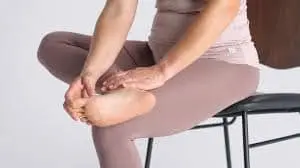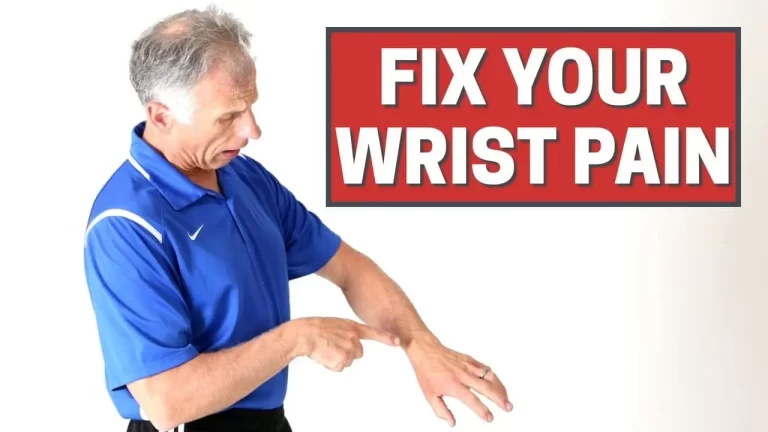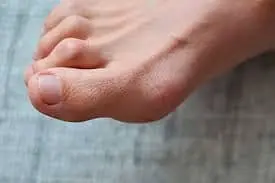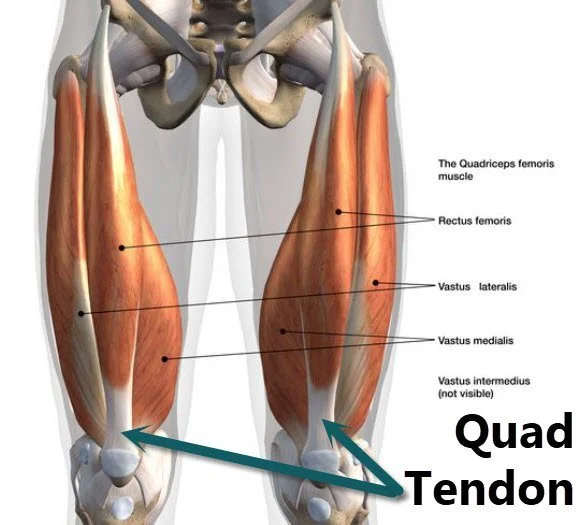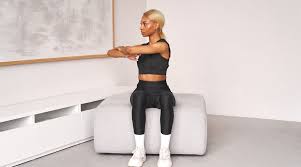15 Best Exercise for Hallux Rigidus
Exercise for Hallux Rigidus is an important component of your total treatment plan, along with splinting, medicine treatment, and physical therapy.
Exercise regularly can help manage hallux rigidus, but it’s important to select activities that don’t make the problem worse, for those who have hallux rigidus, low-impact, non-weight-bearing exercises are excellent. These exercises help in the maintenance of general joint mobility and cardiovascular health without overly straining the damaged joint.
Introduction:
Hallux rigidus is the name given for a foot deformity. The condition is characterized by the development of osteoarthritis in the first metatarsophalangeal joint, which is linked to the first big toe on the foot. This illness can cause foot pain and difficulty walking. In this situation, there is a problem with toe movement and your big toe gets extremely rigid.
Your big toe can become extremely painful to move when you have a frozen joint, which is the inability to bend your toe after rest. the big toe’s surrounding region gets stuffed and inflamed. You feel or have more pain in your big toe in the cold. It is known as the hallux rigidus ailment because the primary cause of your stiffness is a severe, deep (dull ache pain).
When you have hallux rigidus, you have significant trouble performing daily tasks. This severe pain may cause you to change your gait, or how you move, which could lead to issues with your back, hip, or knee.
You can find a lot of exercises for the hallux rigidus problem on this page. Exercises for range of motion, stretches, strength training, and finishing with massages for the stressed foot muscles were all included in the routine. Exercise improves muscle strength and relaxes tense muscles while also maintaining or increasing joint mobility.
Causes:
- Gout
- Rheumatoid arthritis, for example, or other forms of inflammation
- Stress on the big toe repeatedly
- Flat foot deformity
- Osteoarthritis
Signs and symptoms:
- Stiffness in the big toe area
Another common symptom of arthritis that may be caused by changes in the cartilage is stiffness. Your big toe may be difficult for you to flex.
- Swollen area surrounding the big toe
The big toe is not a modification to the general rule that swelling is an indication of arthritis, which is put on by a buildup of fluid in the joints. If your arthritis symptoms have flared up and you have increased swelling around your big toe joint, it could be harder to wear certain shoes comfortably.
- Pain in the area of your big toe
Walking or standing up can often cause pain for those who have hallux rigidus. The pain is typically felt on the outside of the joint, but it can also be felt deep within. This is because your big toe bears the majority of your weight when you stand.
- Limit the movement of your big toe.
- A callus or bunion-like lump that forms on the outer edge of your big toe joint. Irritation and edema are potential causes of this. “That area might also appear red,”
Take these safety measures into consideration before beginning an exercise program:
Before starting any exercise program, it is important to take a few safety precautions and maximize the advantages. Consult your physician or physical therapist to determine which exercises are most effective for your specific problem.
It’s critical to pay attention to your body and refrain from pushing force when in pain. While some soreness is a common side effect of exercise, persistent or intense soreness may be a sign of overworking.
Maintaining proper form and technique is essential to avoiding repeated injuries. Consider medical advice if you’re unsure about how to carry out an exercise program correctly. Warming up before an exercise session will help your joints and muscles get ready for the activity.
Exercise for Hallux Rigidus:
Exercises such as the ones listed below are frequently advised for patients with this illness. Consult your physical therapist regarding the suitability of these exercises before beginning.
Always start slowly and work your way up to a stronger degree of activity or a longer activity period as okay. You should stop exercising and see your doctor if you feel any pain or discomfort during or after.
Towel curls
The purpose of towel curls, also known as scrunches, is to build up and straighten the big toe. They improve your balance and foot stability by strengthening and stretching the tendons and muscles in your feet.
- Place your heels under your knees when sitting.
- Verify that the toes of both your feet and legs point forward and that they are level with one another.
- After spreading the towel, place a level foot on top of it.
- The towel will start to come in your direction.
- Simply keep your heel down and flex your foot backward while you elevate your toes.
- Stretch your foot equally on all sides and in the center, keeping your heel on the towel, to extend it as far as you can.
- Squeeze the towel in with your toes and upward while maintaining an upright heel position.
- Holding the towel, pull it toward you.
- Draw a wide circle under the arch area with all five fingertips on either side of the foot.
- The towel can only be moved in a certain area each time you push back and extend.
- Then return to your neutral position.
- Then relax.
- Repeat this exercise five to ten times.
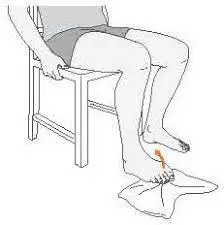
Foam Roll
- First, take a seat in the chair.
- Place a foam roller or golf ball on the ground close to your feet.
- To move the ball around as much as it feels comfortable, plant one foot and press down.
- The bottom of the foot has to be massaged with the ball.
- Once you’ve reached a sensitive location, apply more pressure and continue massaging the area until you feel the pressure.
- The next two to three minutes should be spent moving the ball in this manner.
- Then return to your neutral position.
- Then relax.
- Repeat this exercise five to ten times.
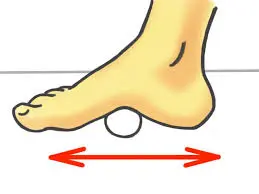
Toe raise, point, and curl
- A seat should be taken, you should sit up straight, and your feet should be flat on the floor.
- As you maintain your toes firmly planted, raise your heels.
- When your sole remaining body part on the ground is your feet, stop.
- You should get off your heels after a few seconds of holding this posture.
- For the next stage, keep your heels up and your toes pointed down, only letting the tips of your big and second toes touch the floor.
- Hold this pose for a few seconds.
- Toe tips just contact the floor in the third stage as you raise and curl your heels inward.
- For a few seconds, maintain this pose.
- Then return to your neutral position.
- Then relax.
- Repeat this exercise five to ten times.
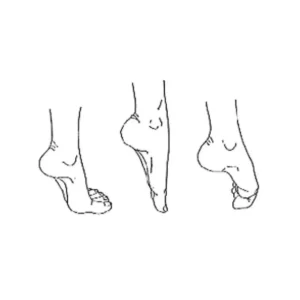
Toe splay
A simple yet effective exercise that helps flex and develop your toes, especially the big toe that has been affected by hallux rigidus, is toe splay. Stretching the ligaments and muscles of your foot helps reduce the risk of additional injury, increase stability and balance, and relieve pain and tightness in the joint.
- Place your feet firmly on the floor and sit with your back straight in a chair.
- As far apart as you can without getting harmed, spread your toes.
- Hold this position for a few seconds.
- Then return to your neutral position.
- Then relax.
- Repeat this exercise five to ten times.
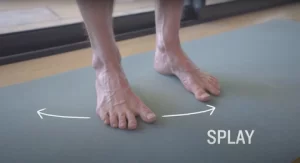
Ankle pump
- This releases tension from your toe joints by causing them to move.
- Start with a sitting position on the bed.
- The foot should be rotated 10 to 20 times in a clockwise direction first.
- Make ten to twenty more circles in the other direction after you’re done.
- Then return to your neutral position.
- Then relax.
- Repeat this exercise five to ten times.
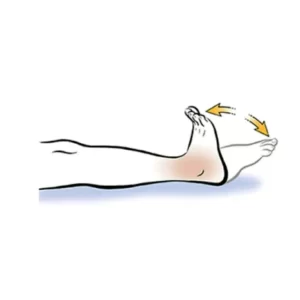
Marble pickup
- Using both feet flat on the ground, sit down straight in a chair.
- Place two bowls on the ground in front of the feet; one bowl should be empty and the other should be filled with ten to twenty marbles minimum.
- To plant each one in the empty bowl, you simply need to use the toes of one foot.
- Then return to your neutral position.
- Then relax.
- Repeat this exercise five to ten times.
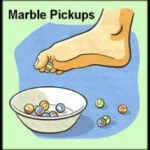
Ankle circle
- Put a towel roll beneath your ankle.
- It is advised to gently rotate your ankle ten times, clockwise and counterclockwise.
- Make sure you are only moving your foot and ankle and not your entire leg.
- To vary up the stretch, try circling the letters with your big toe.
- Then return to your neutral position.
- Then relax.
- Repeat this exercise five to ten times.
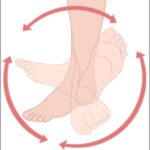
Heel raise
- Take a comfortable standing stance to begin.
- Hold on the chair’s back for support.
- Lift your heels off the ground in order to take a stance on them.
- Hold this position for a few seconds.
- Next, drop your heels.
- Then return to your neutral position.
- Then relax.
- Repeat this exercise five to ten times.

Toe Stretch
- Locate a relaxing spot on the bed or table to start.
- Put one hand’s fingers around your big toe and the other’s around your leg.
- Stretch it out for a few seconds in each of the following directions: up, down, and sideways.
- Then return to your neutral position.
- Then relax.
- Repeat this exercise five to ten times.

Calf stretch
Your big toe joint can be greatly relieved and your entire foot flexibility increased by stretching your calf muscles.
- Place your hands on the wall for support while you stand facing a wall to complete the calf stretch.
- Move your foot such that your heel makes contact with the floor.
- Remember to keep the back of your leg straight while keeping your heel grounded.
- Hold this position for a few seconds.
- Then return to your neutral position.
- Then relax.
- Repeat this exercise five to ten times.
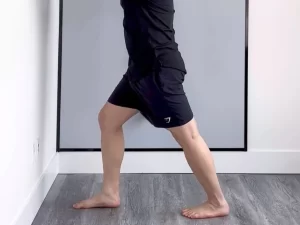
Sand walking
- You can develop strong, flexible legs and strong calves by taking barefoot walks in the sand.
- Change to laps sooner if you’re feeling very exhausted because walking in the sand is more strenuous than walking on firm surfaces.
- If you’re at a beach, desert, or volleyball court, look for sand.
- Take your socks and shoes off.
- After that, take a short walk.
- Then relax.
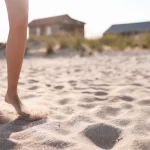
Figure eight rotation
- For this condition, the figure eight rotation exercise is rather easy, much like the toe curl exercise.
- Just make a figure eight with your big toe (not a circle, but this way of moving your toes) and do it.
- The big toe muscles’ range of motion and flexibility are both improved by it.
- Then return to your neutral position.
- Then relax.
- Repeat this exercise five to ten times.
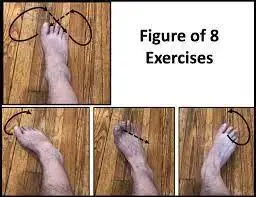
Toe resistance exercises
- You needed a resistance band to complete this exercise.
- Using a resistance band (theraband), sit for an extended on a mat or plinth.
- Grasp both ends of a resistance band with your hands while you loop your big toe.
- Now pull your big toe towards your body.
- Hold this position for a few seconds.
- Then return to your neutral position.
- Then relax.
- Repeat this exercise five to ten times.
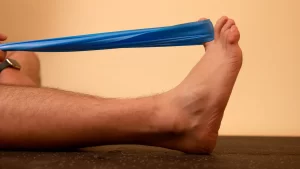
Alphabet write with the toe exercise
To increase the mobility of your big toe and ankles, try writing the alphabet with it.
- Find a spot to sit or stand comfortably.
- Lift your foot a few inches and use your big toe to write the alphabet in the air starting with the capital letters.
- Use lengthy, downward movements.
- Once you’ve finished writing the alphabet, move on to lowercase characters.
- Then return to your neutral position.
- Then relax.
- Repeat this exercise five to ten times.

Single Leg Balance On a Cushion
- Place a cushion on the ground.
- Begin in a comfortable standing posture on the ground.
- Now, put your hands by your sides and bend one knee.
- Hold this position for a few seconds.
- Lower your leg then.
- Then return to your neutral position.
- Then relax.
- Repeat this exercise five to ten times.
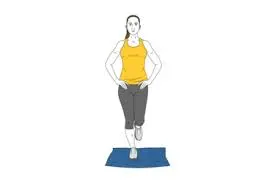
What safety precautions must be taken while exercising?
- Always warm up and stretch before and after your workout.
- When you exercise, maintain a straight posture.
- Choose loose, casual clothing that promotes relaxation and maximal range of motion for the best possible training experience. Avoid wearing clothes that are too tight or stylish.
- Try not to use any forceful or jerky motions when working out.
- Stay away from challenging activities.
- Rest in between your workouts.
- Perform gentle stretches and bends.
- Stretches should be performed before and after sets, along with the appropriate number of repetitions for each exercise, following the protocol.
- Although it may be challenging, stretching the tense muscles in your joint is essential and typical. Exercise and stretching shouldn’t hurt or make you feel as though someone is stabbing you because doing so is unhealthy and exacerbates your illness.
- If the pain worsens, quit immediately.
When do you stop performing the workouts?
- High fever
- Headache
- If exercising hurts, don’t continue.
- Intense muscle burning.
- You feel unwell.
- If there’s any pain or numbness.
How may Hallux rigidus be prevented?
Although you can’t stop hallux rigidus from happening, you might be able to slow down its progress if you do the following;
- To maintain mobility in your big toe joint, exercise.
- After an intense exercise session, give your joints some rest; never push yourself while in pain.
- Put on comfortable shoes and allow sufficient space for your toes.
Summary:
Your big toe’s initial joint may develop Hallux Rigidus, a degenerative arthritis. The cartilage covering your big toe bones starts to break down or become injured, causing the space between them to decrease and ultimately causing pain and suffering.
Even though your big toe is small, it surprisingly contributes significantly to your ability to move around. Walking, running, standing on the heel of your feet, and even standing still would be much more difficult without it. So, it can be uncomfortable and difficult to go about doing everyday tasks when your big toe hurts.
This exercise will engage the entire foot, which has major benefits for strength and mobility. Along with reducing pain, the exercise also helps you move better overall, which is beneficial when going about everyday tasks.
FAQ:
Does Hallux rigidus receive treatment through physical therapy?
Because physical therapy increases the range of motion in the joint and strengthens the surrounding muscles, it can help cure hallux rigidus.
With hallux rigidus, is walking still possible?
A hallux rigidus, often known as a stiff big toe, can develop from stiffness in the joint at the base of the phalange. Walking can be uncomfortable and challenging due to this sort of foot arthritic condition, which is somewhat common. The average age range for symptoms in adults with hallux rigidus is thirty to sixty years old.
Is it ok to massage the hallux rigidus?
To relieve your pain and help the joints move within their normal range, a hands-on treatment like soft-tissue massage for the calf and foot muscles, traction, and mobilizations of the big toe joint and other ankle or foot joints may be performed.
Can the Hallux rigidus recover by itself?
If treatment is not received for hallux rigidus, the condition will only worsen. This means that it will eventually make it impossible for you to stand, walk, or wear shoes, in addition to creating chronic foot issues and impacting other body parts.
Does heat help with the hallux rigidus?
The initial line of treatment for hallux rigidus is always non-surgical care. To ease pain, a doctor might advise using cold or heat packs, painkillers, and anti-inflammatory medications.
How may hallux rigidus be treated non-surgically?
For this illness, nonsurgical care is always the initial course of treatment. To treat pain and stiffness, a doctor could advise using cold or heat packs, medications called anti-inflammatory painkillers, or even joint injections.
Which exercise is most effective for treating Hallux rigidus?
Toe curl
Toe resistance exercises
Toe stretch
Heel raise
Does hallux rigidus spread?
When you have hallux rigidus, you have significant trouble performing daily tasks. You may need to modify your gait due to this intense pain, which may result in problems with your knee, hip, or even your back. So this joint is affected by the chronic stage of this illness.
Which exercises should I stop doing if I have toe arthritis?
You might want to avoid or stop some specific types of exercise if you have arthritis. Running, jogging, jumping rope, and intense aerobic exercise are high-impact exercises that should be avoided when suffering from joint-damaging arthritis. Excessive physical activity or high-impact workouts performed while suffering from this illness might worsen joint pain, cause inflammation, and break down the cartilage in the joints.
For hallux rigidus, how long does recovery take?
Usually, six months following surgery, patients can resume their regular activities, including walking and engaging in high-impact sports. edema may occur following surgery, but within a year of the procedure, recovery should be complete and any edema should have decreased. Following surgery, you can go to the physical therapy facility to improve your range of motion, flexibility, and muscle strength.
References:
- 2024, September 13; Hallux Rigidus. Cleveland Clinic. The following link: https://my.clevelandclinic.org/health/diseases/14665-hallux-rigidus
- August 29, 2024; Yeargain, J. Hallux Rigidus: 5 Quick Exercises for Building Muscle. Gain Ankle & Foot Yeargain. Exercises for Hallux Rididus: https://dryeargain.com/
- Calf Extension. (n.d.). [Video]. https://www.hingehealth.com/resources/articles/hallux-rigidus/ Hingehealth
- On May 28, 2023, Adebajo, B., and Štefanović, D.There are four ways for treating big toe arthritis or hallux rigdus. Upstep. Exercises to prevent big toe arthritis (hallux rigidus) https://www.upstep.com/a/blog/?srsltid=AfmBOoq_diHrJL_jKyBccB2lINlaBI-n4yuzwJsp_0kVayp6cybtG53V
- 2024, May 22; raymond.delpak. Doctors Delpak and Errico of exas Foot and Ankle Consultants: 5 Simple Activities for the Hallux Rigidus to Help with Pain Relief and Increased Mobility. Drs. Errico and Delpak of Texas Foot and Ankle Consultants. To alleviate pain and improve range of motion, try these five simple exercises for the hallux rigidus: This website, txfootandankleconsultants.com
- Image 12, On July 24, 2023a, Prajapati, D. Physio Samarpan: The Top 19 Exercises for the Hallux Rigidus. Physiotherapy Clinic in Samarpan. The ideal exercise for treating hallux rigidus is this one: The URL is https://samarpanphysioclinic.com/19
- Image 15, Exercises, regimens, and routines related to Single-Leg Pillow Balance. (No date). The single-leg pillow balance exercise is available at https://www.workoutsprograms.com.

